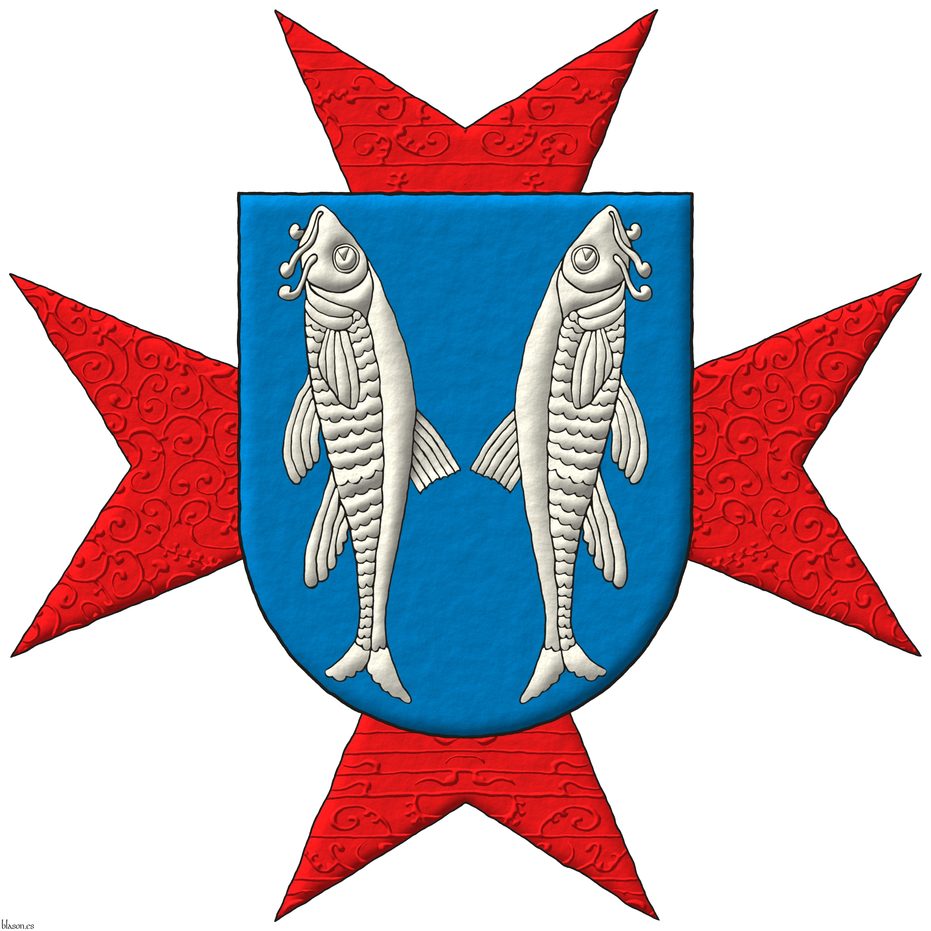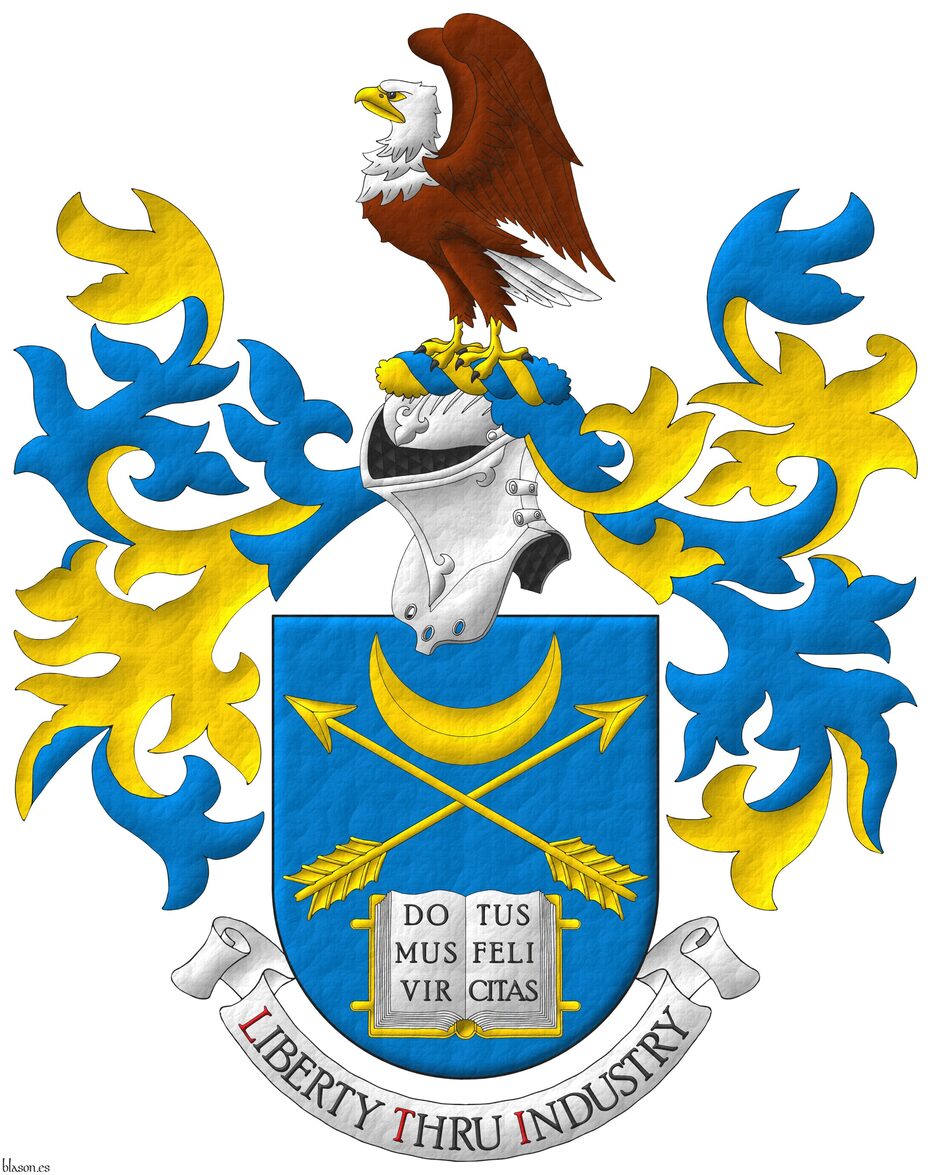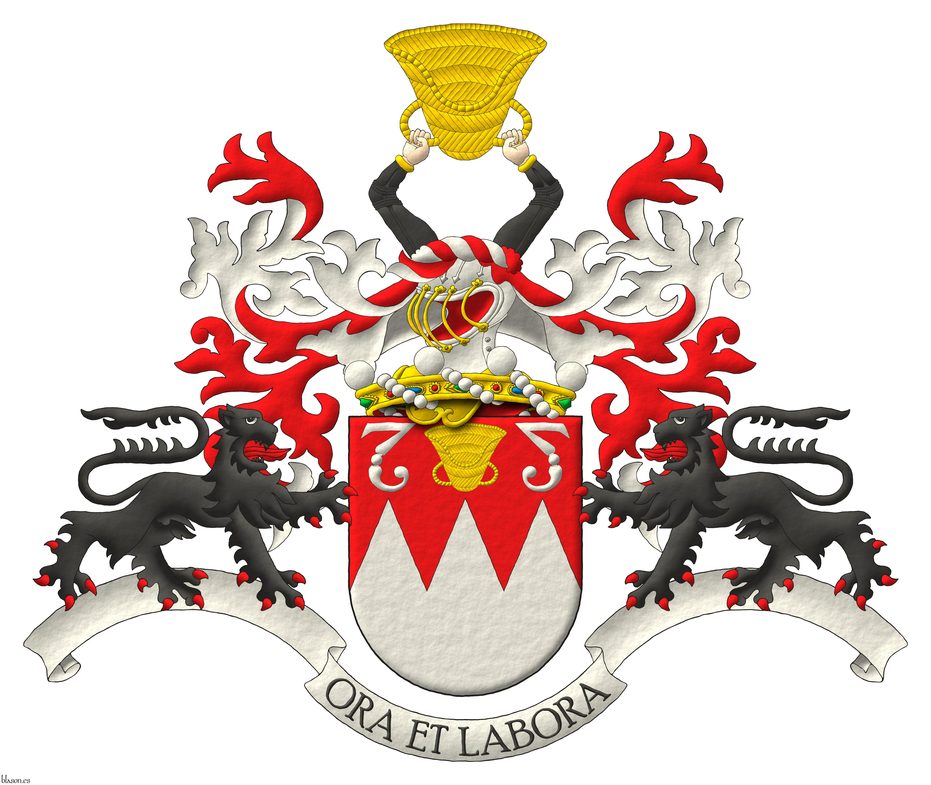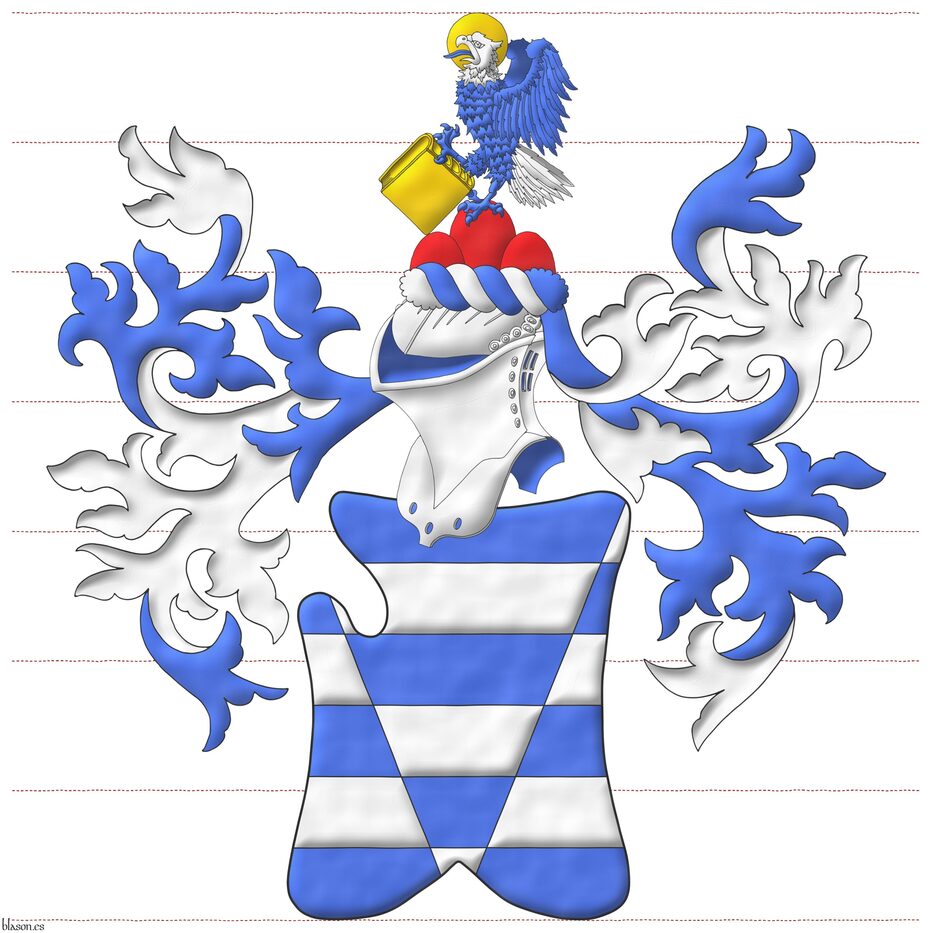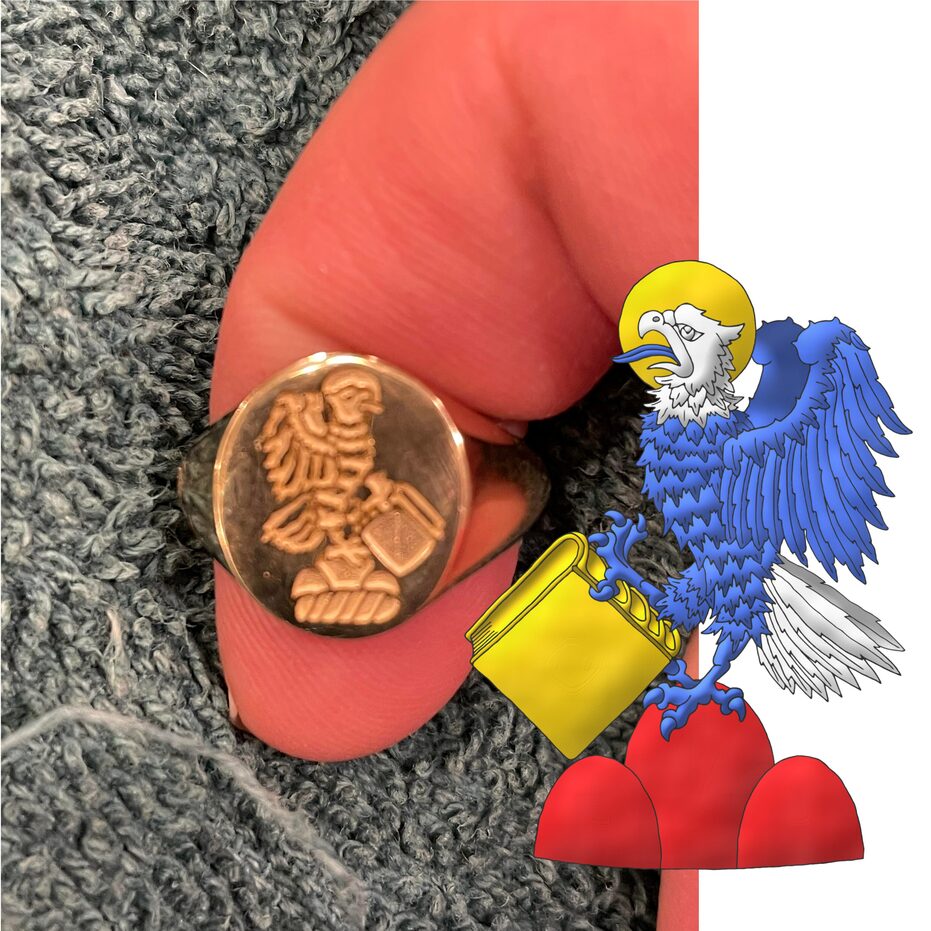Addorsed


Alea Capital
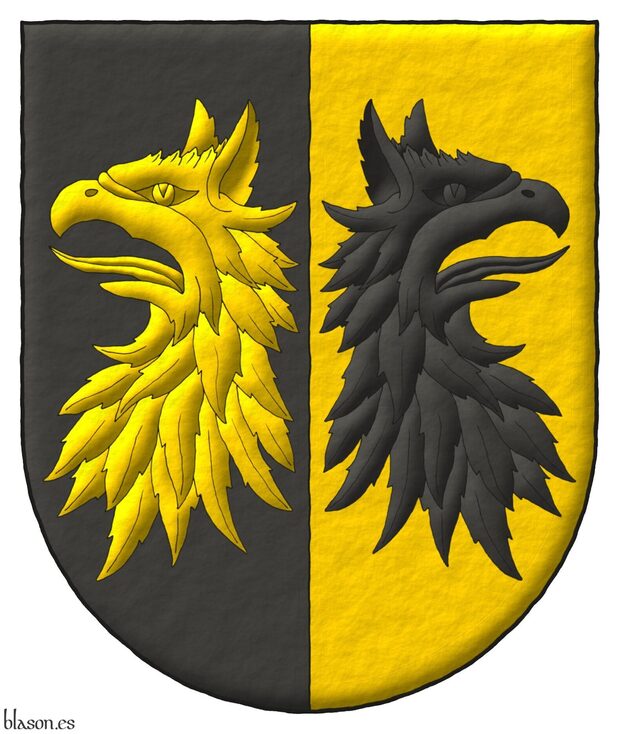
Party per pale Sable and Or, two griffins' heads eraticted, and addorsed counterchanged.
Escudo partido de sable y oro, dos cabezas de grifo arrancadas y adosadas del uno en el otro.
Coat of arms emblazoned by me with a semi-circular shape, illuminated, and with a freehand finishing.
Blazon keywords: Party per pale, Sable, Or, Two, Head, Griffin, Erased, Addorsed and Counterchanged (side-by-side).
Style keywords: Outlined in sable, Semi-circular, Illuminated and Freehand.
Classification: Socioeconomic, Created and Coat of arms.
Bearer: Alea Capital.


André de Montbard
Azure, two barbels addorsed Argent. Behind the shield an eight-pointed cross patty Gules.
Blazon keywords: Azure, Two, Barbel, Addorsed, Argent, Behind the shield, One, Eight-pointed cross, Cross couped and Gules.
Style keywords: Outlined in sable, Semi-circular, Illuminated and Freehand.
Classification: Religious, Military, Knights Templar, Interpreted and Coat of arms.
Bearer: Montbard, André de.


Crest of Reynaldo Romero
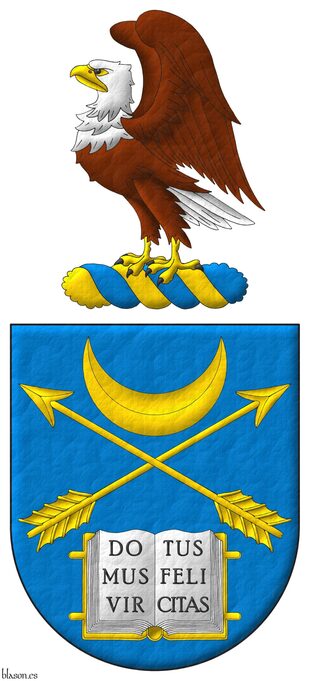
Azure, two arrows points upwards in saltire between, in chief a crescent Or, in base an open book Argent, garnished Or, the pages inscribed «Domus Virtus Felicitas» Sable. Crest: Upon a wreath Or and Azure, a bald eagle rising, wings addorsed and inverted proper.
Arms painted by me, highlighted with lights and shadows, contoured in Sable, with a semi-circular outer contour and with a leather finish.
Blazon keywords: Azure, Or, Argent, Sable, One, Two, Arrow, Point upwards, In saltire, Between, In chief, Crescent, In base, Open book, Book, Page, Inscribed, Crest, Upon (wreath), Wreath, Bald eagle, Eagle, Rising, Wing, Addorsed and Proper.
Style keywords: Outlined in sable, Illuminated, Semi-circular and Leather.
Classification: Personal, Interpreted, Boa and Coat of arms.
Bearer: Romero, Reynaldo.


Crest, mantling and motto of Reynaldo Romero
Azure, two arrows points upwards in saltire between, in chief a crescent Or, in base an open book Argent, garnished Or, the pages inscribed «Domus Virtus Felicitas» Sable. Crest: Upon a helm with a wreath Or and Azure, a bald eagle rising, wings addorsed and inverted proper. Mantling: Azure doubled Or. Motto: «Liberty Thru Industry».
Arms interpreted by me, highlighted with lights and shadows, contoured in Sable, with a semi-circular outer contour and with a leather finishing.
Blazon keywords: Azure, Or, Argent, Sable, One, Two, Arrow, Point upwards, In saltire, Between, In chief, Crescent, In base, Open book, Book, Page, Inscribed, Crest and mantling, Crest, Upon (wreath), Helm, Wreath, Bald eagle, Eagle, Rising, Wing, Addorsed, Proper, Mantling and Motto.
Style keywords: Outlined in sable, Illuminated, Semi-circular and Leather.
Classification: Personal, Interpreted, Boa and Coat of arms.
Bearer: Romero, Reynaldo.


Full achievement of Markus Hermann Frank
Party per fess dancetty of three points Gules and Argent, in chief a winnowing fan reversed Or between two fleams addorsed Argent. Crest: Upon a helm befitting his degree issuant from a crown of Baron above the shield, with a wreath Argent and Gules, two arms embowed proper, vested Sable, cuffed Or, holding aloft a winnowing fan reversed Or. Mantling: Gules doubled Argent. Motto: «Ora et Labora». Supporters: Two lions passant, tails addorsed Sable, armed and langued Gules.
Coat of arms depicted by me, illuminated with lights and shadows, outlined in Sable, with a semi-circular outer contour and with a freehand finish.
G0129, Chief Herald of Arms of Malta's grant for the arms of Markus Hermann Frank, USA. These arms have been emblazoned by me for such grant.
Blazon keywords: Gules, Argent, Or, Sable, One, Two, Three, Party per fess, Dancetty, In chief, Winnowing fan, Reversed, Between, Fleam, Addorsed, Crest, Upon (wreath), Helm, Issuant, Crown of Baron, Crown, Above the shield, Wreath, Arm, Embowed, Proper, Vested, Cuffed, Grasping, Mantling, Doubled, Motto, Supporter (animal), Supporter, Lion, Passant, Tail addorsed, Armed and Langued.
Style keywords: Outlined in sable, Illuminated, Semi-circular and Freehand.
Classification: Personal, Interpreted, Boa and Coat of arms.
Bearer: Frank, Markus Hermann.


Herbert Leo Buffenbarger, schema 1x1
Barry of six, Argent and Azure, a pile throughout, counterchanged. Crest: Upon a helm with a wreath Argent and Azure, upon a trimount Gules, an eagle wings addorsed and inverted Azure, the head and tail Argent, nimbed and grasping a closed book Or. Mantling: Azure doubled Argent.
These are the arms of Herbert Leo Buffenbarger, designed by his son John Alan Francis Buffenbarger, and emblazoned by me. As shown in the image diagram, I have used a 2:2:3 ratio between the height of the crest, the height of the helm, and the height of the shield.
Blazon keywords: Argent, Azure, Gules, Or, One, Six, Three, Barry, Counterchanged, Pile, Throughout (chief base), Chaussé, Crest and mantling, Crest, Upon (wreath), Helm, Wreath, Upon, Trimount, Eagle, Wing, Addorsed, Head, Tail, Nimbed, Grasping, Closed book, Book and Mantling.
Style keywords: Ratio, Outlined in sable, Illuminated and Jousting.
Classification: Personal, Interpreted, Schema, Boa and Coat of arms.
Bearer: Buffenbarger, Herbert Leo.


![Ver [Norsk Heraldisk Forening] en instituciones citadas. Fortaleza de oro y mazonada de sable.](../css/Fortaleza.Institucion.png)
Norsk Heraldisk Forening
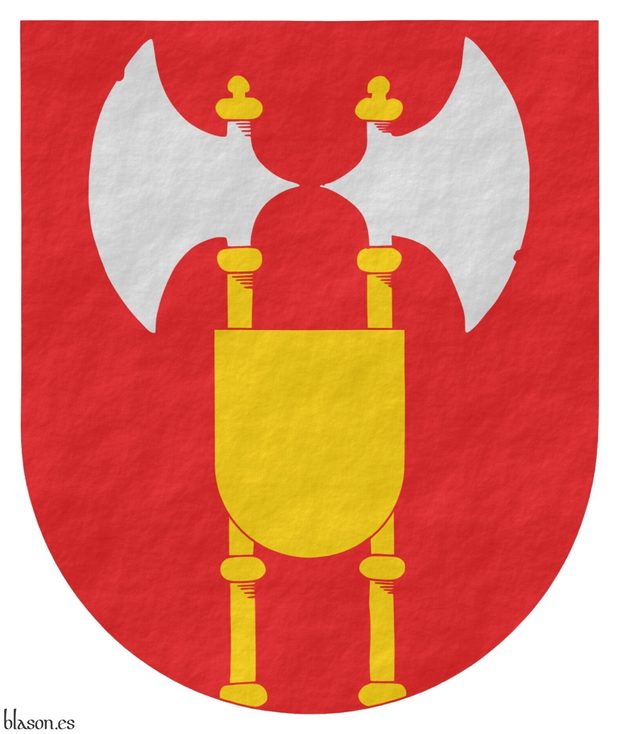
Norsk Heraldisk Forening, in English, Nordic Heraldry Society, was founded on February 27, 1969, at the National Archives in Oslo, with the aim of promoting the study and knowledge of heraldry through meetings, lectures, excursions, and other dissemination methods, and additionally, to become an advisory body to resolve issues in matters of heraldry, flags, personal coats of arms, etc. Its first president was Dr. Philos Herman L. Løvenskiold.
Since then, these have remained the objectives of the Norsk Heraldisk Forening, and its membership count has remained between 150 and 200 members, and it cooperates with the Nordic Heraldry Society, «Societas Heraldica Scandinavica».
The website's address is Heraldikk.no, its content is available in both Norwegian and English, and they work systematically to expand it and provide greater and better information to both its members and those interested in heraldry.
Blazon
Alex Maxwell Findlater described it in English, including its crest, in an article that was on their previous website under the title «About the society», as follows: «Gules issuant from base two battle-axes addorsed Argent shafted Or overall at the nombril point an escutcheon Or; for Crest between two axes of the arms a panache of three peacock feathers proper; Mantling Gules doubled Or». But given that «shafted» applies to weapons with a shaft and «hafted» to weapons with a handle, in the case of axes, I use «hafted» although both terms correspond to the Spanish «fustado».
Note how the axes are described as battle-axes, just as in the blazon of the Norwegian coat of arms, where its lion holds a battle-axe.
Coat of arms I attempted to interpret in the Norwegian style, all in flat tinctures, without Sable outlines, lighting or shading, and only with a simple rough finish.
Categories: Institution, Interpreted, Socioeconomic, Semi-circular, Plain tincture, Outlined in the field tincture, Rough, Coat of arms, Without divisions, Gules, Axe, Argent, Hafted, Or, Addorsed, Issuant from base, Overall, At the nombril and Escutcheon.


Norsk Heraldisk Forening, coat of arms
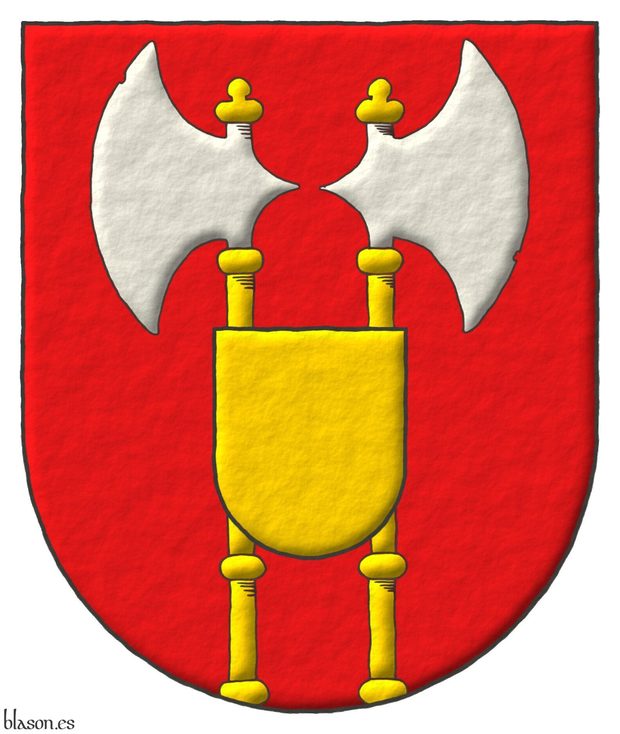
Gules, two axes addorsed Argent, hafted Or, issuant from the base; overall, at the nombril, an escutcheon Or.
Escudo de gules, dos hachas adosadas de plata, fustadas de oro, movientes de la punta; brochante sobre el todo, en el ombligo, un escudete de oro.
Interpretation I have made with the following characteristics: the escutcheon is semicircular, in the classic Castilian style; its field is illuminated with the tincture gules; its 2 axes and escutcheon are outlined in sable and illuminated with the metal Or, and the axe heads in Argent; and the execution is in a raised line style.
Hafted or shated
The term «hafted» in English is specifically used for weapons with handles, such as axes and hammers. This refers to the part of the weapon where the user grips, which is typically made of wood or metal and is essential for wielding the weapon effectively. The haft is integral to the weapon's function, providing the necessary leverage and control during use.
On the other hand, «shafted» is a term used in English for weapons with a shaft, which is a longer, slender part of the weapon, as seen in spears, arrows, and sometimes in lances. The shaft is usually the primary structural component, providing the length and reach, while also serving as the backbone of the weapon.
In both cases, the term indicates that this part of the weapon is of a different tincture from the rest of the figure.
In Castilian, however, both «hafted» and «shafted» translate to «fustadas», which broadly refers to a similar concept where the handle or shaft is of a different color than the head or blade.
Then, I prefer using «hafted» when referring to axes and hammers due to the specificity of the term in English.
This contrasts with the term «guarnezidas» ~ «hilted», which is used for swords, indicating a different color for the guard or hilt, rather than for the shaft or handle.
Addorsed, back to back
For the arrangement of the axes in relation to each other, the one on the dexter facing dexter, the one on the sinister facing sinister, I use the term «addorsed» as it is the most common, but I previously used «back to back», which is said of «two animals, rampant, with their backs against each other, each facing the opposite flank. Two keys are also described as back to back when they are positioned with the bits outward, each to its side; the same applies to sickles, or scythes and generally to all long objects that have two faces, like two axes...» [Avilés, J.; 1780a; page 98], this being the case for the axes in this shield.
«Dalla» is a synonym for «scythe» used in and originating from Aragon and Navarra, [Real Academia Española; 2001].
In the English blazon, «adosadas», «de espaldas», is rendered as «addorsed», from the French «adossé», which is said, for example, when «two animals turned back to back» and some also use «endorsed».
Blazon keywords: Without divisions, Gules, Axe, Argent, Hafted, Or, Addorsed, Issuant from base, Overall, At the nombril and Escutcheon.
Style keywords: Semi-circular, Illuminated, Outlined in sable and Freehand.
Classification: Interpreted, Socioeconomic and Coat of arms.
Bearer: Norsk Heraldisk Forening.


Quartered arms of André de Montbard
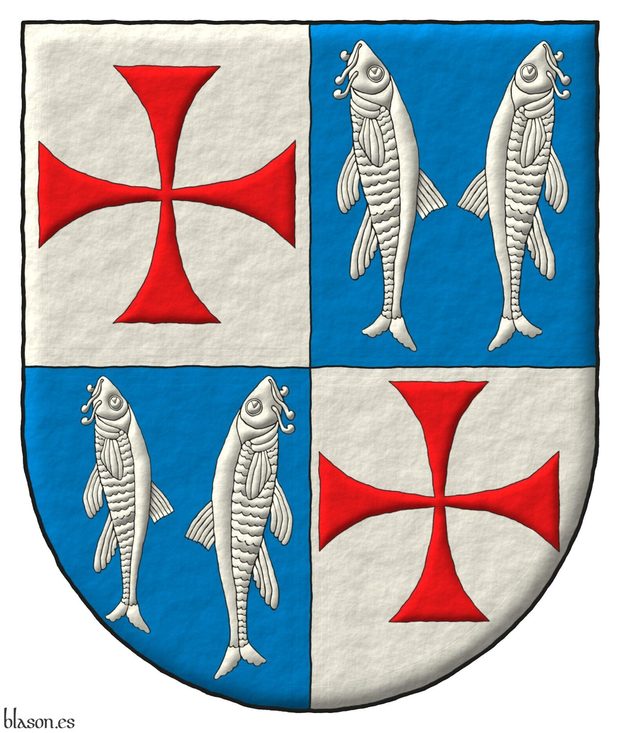
Quarterly: 1 and 4 Argent, a cross patty Gules; 2 and 3 Azure, two barbels addorsed Argent
Escudo cuartelado: 1o y 4o de plata, una cruz patada de gules; 2o y 3o de de azur, dos barbos adosados de plata.
Blazon keywords: Azure, Two, Barbel, Addorsed, Argent, Quarterly, One, Cross patty, Cross couped and Gules.
Style keywords: Outlined in sable, Semi-circular, Illuminated and Freehand.
Classification: Religious, Military, Knights Templar, Interpreted and Coat of arms.
Bearer: Montbard, André de.


Seal of Herbert Leo Buffenbarger
Upon a wreath Argent and Azure, upon a trimount Gules, an eagle wings addorsed and inverted Azure, the head and tail Argent, nimbed Or, grasping a closed book also Or.
The signet ring featuring the crest of the arms of Herbert Leo Buffenbarger, based on his heraldic crest. The crest was designed by his son, John Alan Francis Buffenbarger, and emblazoned by me. The image shows the signet ring featuring the crest upon a wreath, alongside my painting of the crest upon which the ring is based.
Blazon keywords: Crest, Argent, Azure, Gules, Or, One, Three, Upon (wreath), Wreath, Upon, Trimount, Eagle, Wing, Addorsed, Head, Tail, Nimbed, Grasping, Closed book and Book.
Style keywords: Outlined in sable and Illuminated.
Classification: Personal, Interpreted, Boa, Seal, Collage and Photographic.
Bearer: Buffenbarger, Herbert Leo.
-
Language
-
Categories of heraldry
-
Divisions of the field
- Without divisions
- Party per pale
- Party per fess
- Party per bend
- Party per bend sinister
- Tierce
- Tierce sinister
- Tierced per pale
- Tierced per fess
- Tierced per bend
- Tierced pallwise inverted
- Quarterly
- Quarterly per saltire
- Gyronny
- Party per fess, the chief per pale
- Party per pale, the sinister per fess
- Party per fess, the base per pale
- Party per pale, the dexter per fess
- Chapé
- Chaussé
- Embrassé
- Contre-embrassé
- Party per chevron
- Enté
- Enté en point
- Flanched
-
Metals
-
Colours
-
Furs
-
Other tinctures
-
Ordinaries and sub-ordinaries
-
Diminutives of the ordinaries
-
Geometric charges
-
Composite ordinaries
-
Inanimate charges from Nature
Atom, Crescent, Diamond, Emerald, Estoile, Increscent, Lightning flash, Moon, Mount, Mullet, Mullet of four points, Orbital, Plough of Ursa Major, Rainbow, Ray of the sun, River, Sea, Snowflake, Sun, Sun in splendour, Sun of May, Trimount, Water and Wave.
-
Vegetal charges from Nature
Acorn, Apple, Apple tree, Ash, Bluebonnet, Camellia, Chrysanthemum, Cinquefoil, Cornflower, Dogwood flower, Double rose, Elm, Fleur de lis, Flower, Gourd, Holm oak, Hop cone, Kapok tree, Laurel, Lily, Linden, Lotus flower, Madonna lily, Mexican cedar tree, Oak, Olive tree, Palm tree, Plantain plant, Pomegranate, Poplar leaf, Rose, Shamrock, Sunflower, Thistle, Tree, Tulip, Vine and Wheat.
-
Animal charges from Nature
Badger, Bald eagle, Barbel, Barn owl, Bear, Beaver, Beetle, Bighorn sheep, Blackbird, Boar, Brach hound, Bull, Doe, Dog, Dolphin, Dove, Eagle, Elephant, Falcon, Female figure, Fish, Flame, Fly, Fox, Frog, Goat, Goldfinch, Goose, Heron, Horse, Hummingbird, Jaguar, Lark, Leopard, Lion, Lion passant, Lion rampant guardant, Lioness, Lynx, Male figure, Martlet, Merino ram, Owl, Panther, Parrot, Peacock, Pelican, Pelican in her piety, Puffin, Quetzal, Raven, Roe deer, Rooster, Savage, Seagull, Serpent, She-wolf, Stag, Starling, Talbot, Tyger, Vulture, Warren hound and Wolf.
-
Parts of natural charges
Arm, Beak, Branch, Caboshed, Chest, Claw, Covert, Dorsal fin, Eagle claw, Ermine spot, Escallop, Feather, Foot (palmiped), Foreleg, Forepaw, Hand, Head, Heart, Hoof, Leaf, Neck, Ostrich feather, Palm frond, Paw, Roe deers' attires, Shoulder, Sprig, Stags' attires, Stem, Swallow-tail, Tail, Tail addorsed, Tail fin, Talon, Tibia, Tooth, Trunk, Trunk (elephant), Two hands clasped, Two wings in vol, Udder, Wheat spike, Wing and Wrist.
-
Artificial charges
Ace of spades, Anchor, Anvil, Arch, Arm vambraced, Armillary sphere, Arrow, Axe, Bell, Bell tower, Beret, Bonfire, Book, Bookmark, Bow, Branding iron, Bridge, Broken, Buckle, Cannon, Cannon dismounted, Cannon port, Canopy roof, Carbuncle, Castle, Celtic Trinity knot, Chain, Chess rooks, Church, Clarion, Clay pot, Closed book, Club, Column, Comb, Compass rose, Conductor's baton, Cord, Covered cup, Crozier, Crucible, Cuffed, Cup, Cyclamor, Dagger, Double vajra, Drum, Ecclesiastical cap, Fanon, Federschwert, Fleam, Four crescents joined millsailwise, Galician granary, Garb, Gauntlet, Geometric solid, Grenade, Halberd, Hammer, Harp, Host, Hourglass, Key, Key ward, Knight, Knot, Lantern, Letter, Line, Loincloth, Menorah, Millrind, Millstone, Millwheel, Monstrance, Mortar, Mullet of six points pierced, Nail, Non-classic artifact, Norman ship, Number, Oar, Oil lamp, Open book, Page, Pair of scales, Parchment, Pestle, Piano, Pilgrim's staff, Plough share, Polish winged hussar, Port, Portcullis, Potent, Quill, Ribbon, Rosette of acanthus leaves, Sabre, Sackbut, Sail, Scroll, Scythe, Sheaf of tobacco, Ship, Skirt, Spear, Spear's head, Stairway, Star of David, Step, Sword, Symbol, Tetrahedron, Torch, Tower, Trident, Trumpet, Turret, Two-handed sword, Wagon-wheel, Water-bouget, Wheel, Winnowing fan and With a turret.
-
Immaterial charges
Angel, Archangel, Basilisk, Dragon, Dragon's head, Garuda, Golden fleece, Griffin, Heart enflamed, Justice, Mermaid, Our Lady of Mercy, Ouroboros, Paschal lamb, Pegasus, Phoenix, Sacred Heart of Jesus, Saint George, Sea-griffin, Trinity, Triton, Unicorn, Winged hand and Wyvern.
-
External elements
-
Heraldic creations
-
References
-
Formats
-
Keywords on this page
Between, Addorsed, Proper, Point upwards, Rising, Azure, Barbel, Boa, Overall, Buffenbarger, Herbert Leo, Wreath, Head, Upon (wreath), Crest, Tail, Crescent, Cross couped, Outlined in sable, Two, At the nombril, In chief, In base, In saltire, Escutcheon, Coat of arms, Arrow, Hafted, Personal, Gules, Axe, Illuminated, Inscribed, Interpreted, Mantling, Motto, Book, Open book, Semi-circular, Wing, Or, Argent, Sable, Socioeconomic, Grasping, Freehand, Three, One, Helm and Eagle.

